On April 11th, Jason Latour announced on his blog the end of Winter Soldier (WS). Thus, I hate Latour and Klein for ending one of my favorite comic books of the last 20 years. Just kidding, Latour and Klein. Stuff happens. DC keeps killing-off Aquaman; Marvel kills Moon Knight and Namor faster than WS kills minions. No harm done. WS will be back; he is too strong a character not to have his own book, own movie, perhaps own cable series.
The theme behind Constant Geography, and in my courses, involves the notion geography is ubiquitous; everything is intrinsically geographic. In my course, I try to illustrate how fundamental geography is in our lives, from our books, music, politics, even popular culture, including comic books.
I am a life-long comic book collector. From my earliest memories, I have appreciated the art, imagination, science, and creativity associated with the comic/graphic novel milieu. As a young boy, I drew my own comics, created my own heroes, my own stories. The writers, illustrators, pencilers, inkers, letterers, developed such intriguing worlds, with fantastic villains attempting to fulfill devastating crimes against society. While I never became 'lost' in the comics, I always found the imagination of the writers astounding, the technology and powers invested in heroes and villains sparking my own imagination. I wanted to be an engineer, an aerospace engineer. I wanted to be the person who built the first starship, or the first transforming aircraft, or the first powered-suit. Yes, I wanted to be Tony Stark. Alas, I am a geographer; the bifurcated paths of life led me away from engineering, nudged off by Calculus III and Thermodynamics.
Comics are more sophisticated than most people give them credit for being. I refer not simply to the use of technology, the publishing technology, the art technology, or even the fictional technologies utilized by comic book heroes. No, I refer to the writing, the character backgrounds, plots, staging, and the underlying geography which provide compelling story environments. Characters have birth places, places of origin, places where their powers are gained, enhanced, exploited, or rendered useless. Comic book action takes place in specific places, both 'real,' meaning a real place on Earth, or imaginary, such as Alternate Realities, the Future, the Past, or other imaginary places, like Krypton, Oa, or Valhalla.
 James Buchanan Barnes, for instance, was born in Shelbyville, IN, in 1925. For those unaware of who James "Bucky" Barnes is, he was the early sidekick to Steve Rogers, a/k/a Captain America. "Bucky" was featured in the 2012 movie, "Captain America: The First Avenger," starring Chris Evans, Samuel L. Jackson, and Hugo Weaving. "Bucky" was portrayed by actor Sebastian Stan.
James Buchanan Barnes, for instance, was born in Shelbyville, IN, in 1925. For those unaware of who James "Bucky" Barnes is, he was the early sidekick to Steve Rogers, a/k/a Captain America. "Bucky" was featured in the 2012 movie, "Captain America: The First Avenger," starring Chris Evans, Samuel L. Jackson, and Hugo Weaving. "Bucky" was portrayed by actor Sebastian Stan.
Comic book writers, especially early authors like Stan Lee, Joe Simon, and Jack Kirby, drew heavily upon traditional cultural traits found predominantly in rural areas. Such traits as 'strong moral fiber,' 'strong work ethic,' 'patriotism,' and a strong inclination towards 'justice' and 'fair play' were common cultural traits which were applied to rural areas. People self-identified with the presumed simple, rustic life represented in rural life.
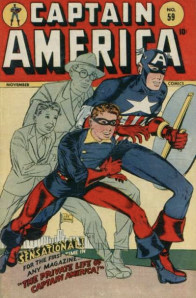
The history of the Winter Soldier begins simultaneously with Captain America. We cannot explore the geography of Barnes without beginning with the transformation of Steve Rogers into Captain America. Joe Simon, Jack Kirby, aided a few years later by Stanley Lieber a/k/a "Stan Lee," deliberately created Captain America as a political icon. In Comic Book Nation (Wright; 2003), the venerable team of artists and writers admitted Captain America was designed as a counter to the growing threat of Nazism. According to Joe Simon, many groups were organizing against Nazi Germany and the German Wehrmacht, and Simon and Kirby wanted to make their voice heard.
Thus, was the character of Steve Rogers born, his transformation into the Captain America via the super-soldier serum was begun. James Barnes would not be the benefactor of any super-soldier serum, not here in the United States, nor abroad. His fate would diverge greatly from Captain America's at the end of World War II, not only in context of the character but also in print.
 James "Bucky" Barnes began life with no "X-factor," no genetic mutation, no alien weaponry, or another augmentation. He was like every other person, i.e. a "normal." In 1940, after accidentally discovering the true identity of Captain America, James was trained by the United States Army. At 15, he was one of the youngest (if not the youngest) enlisted soldier. He followed Captain America on a number of adventures throughout Europe, helping to defeat the Nazis and the hated Red Skull. Both Captain America and Bucky fell victim to the same catastrophe, though. While attempting to disarm a German drone, both Captain America and Bucky were lost in the frigid waters of the North Atlantic. Later, Captain America would be found, thawed, and live on as the superhero as we know him today.
James "Bucky" Barnes began life with no "X-factor," no genetic mutation, no alien weaponry, or another augmentation. He was like every other person, i.e. a "normal." In 1940, after accidentally discovering the true identity of Captain America, James was trained by the United States Army. At 15, he was one of the youngest (if not the youngest) enlisted soldier. He followed Captain America on a number of adventures throughout Europe, helping to defeat the Nazis and the hated Red Skull. Both Captain America and Bucky fell victim to the same catastrophe, though. While attempting to disarm a German drone, both Captain America and Bucky were lost in the frigid waters of the North Atlantic. Later, Captain America would be found, thawed, and live on as the superhero as we know him today.
Bucky was thought "killed in action." The killing of a teenage protagonist, even within the confines of the comic book genre, was not well-received in the popular culture of the 1950s. Bucky's death was used throughout the industry as a reason why adult superheroes should never have teenage sidekicks, especially ones whose only "powers" were wits.
Writers pull themes from popular culture, from all eras and geographies. The Cold War between the United States and the Soviet Union provided immense opportunities for writers to develop adversaries based in Europe, the Union of Soviet Socialist Republics (USSR), East Germany, and the countries behind the Iron Curtain.
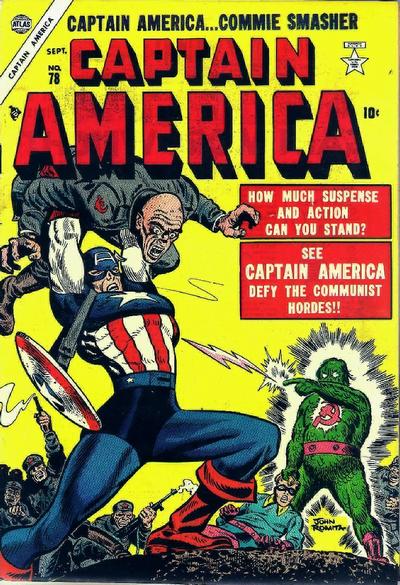 In the early 1950's, Democracy was under threat by Communism, so the sentiment went. After World War II, many realms, regions, and countries were caught in their own internal leadership struggles. China, while warring with Japan in the 1940s, was also in the throes of a civil war. The Korean War (1950 - 1953) would leave a divided peninsula, the northern portion in the hands of Communists, while the southern portion adopted a form of Socialism. The Soviet Union would drape a figurative "iron curtain" of near-impenetrable influence upon adjacent European states, Poland, Czechoslovakia, Hungary, Bulgaria, and Yugoslavia. In 1954, Eisenhower described the adoption of Communism as being like the toppling of dominoes, once one country went Communist, the adjacent country might, too. Even in the United States, the Joseph McCarthy Communism hearings and the subsequent black-listing of politicians, academics, and entertainment personalities, provide evidence no one living in the United States was safe from scrutiny.
In the early 1950's, Democracy was under threat by Communism, so the sentiment went. After World War II, many realms, regions, and countries were caught in their own internal leadership struggles. China, while warring with Japan in the 1940s, was also in the throes of a civil war. The Korean War (1950 - 1953) would leave a divided peninsula, the northern portion in the hands of Communists, while the southern portion adopted a form of Socialism. The Soviet Union would drape a figurative "iron curtain" of near-impenetrable influence upon adjacent European states, Poland, Czechoslovakia, Hungary, Bulgaria, and Yugoslavia. In 1954, Eisenhower described the adoption of Communism as being like the toppling of dominoes, once one country went Communist, the adjacent country might, too. Even in the United States, the Joseph McCarthy Communism hearings and the subsequent black-listing of politicians, academics, and entertainment personalities, provide evidence no one living in the United States was safe from scrutiny. I've neglected to keep up with changes in the comic book publishing realm in my story, as neither Marvel nor DC existed in the early days of Captain America. Atlas Publishing, along with Timely Comics, which both published some early Captain America titles, would eventually evolve into Marvel Comics. In 1953, Atlas would team Captain America, the Human Torch, and Namor, the Sub-Mariner, in a new effort to stomp out Communism. Captain America would become "Captain America, Commie Smasher." Namor was not too impressed with the Red's, either.
I've neglected to keep up with changes in the comic book publishing realm in my story, as neither Marvel nor DC existed in the early days of Captain America. Atlas Publishing, along with Timely Comics, which both published some early Captain America titles, would eventually evolve into Marvel Comics. In 1953, Atlas would team Captain America, the Human Torch, and Namor, the Sub-Mariner, in a new effort to stomp out Communism. Captain America would become "Captain America, Commie Smasher." Namor was not too impressed with the Red's, either.
Comic books embody the same trait as most daytime soap operas; no character ever really dies (unless the actor dies in real-life, of course, and sometimes not even then, due to the miracles of plastic surgery). Same holds true with James Barnes. The very same incident which led to Captain America being trapped in ice led to the eventual capture, imprisonment, and 're-programming' of James "Bucky" Barnes from a World War Two hero into a Soviet spy and assassin.
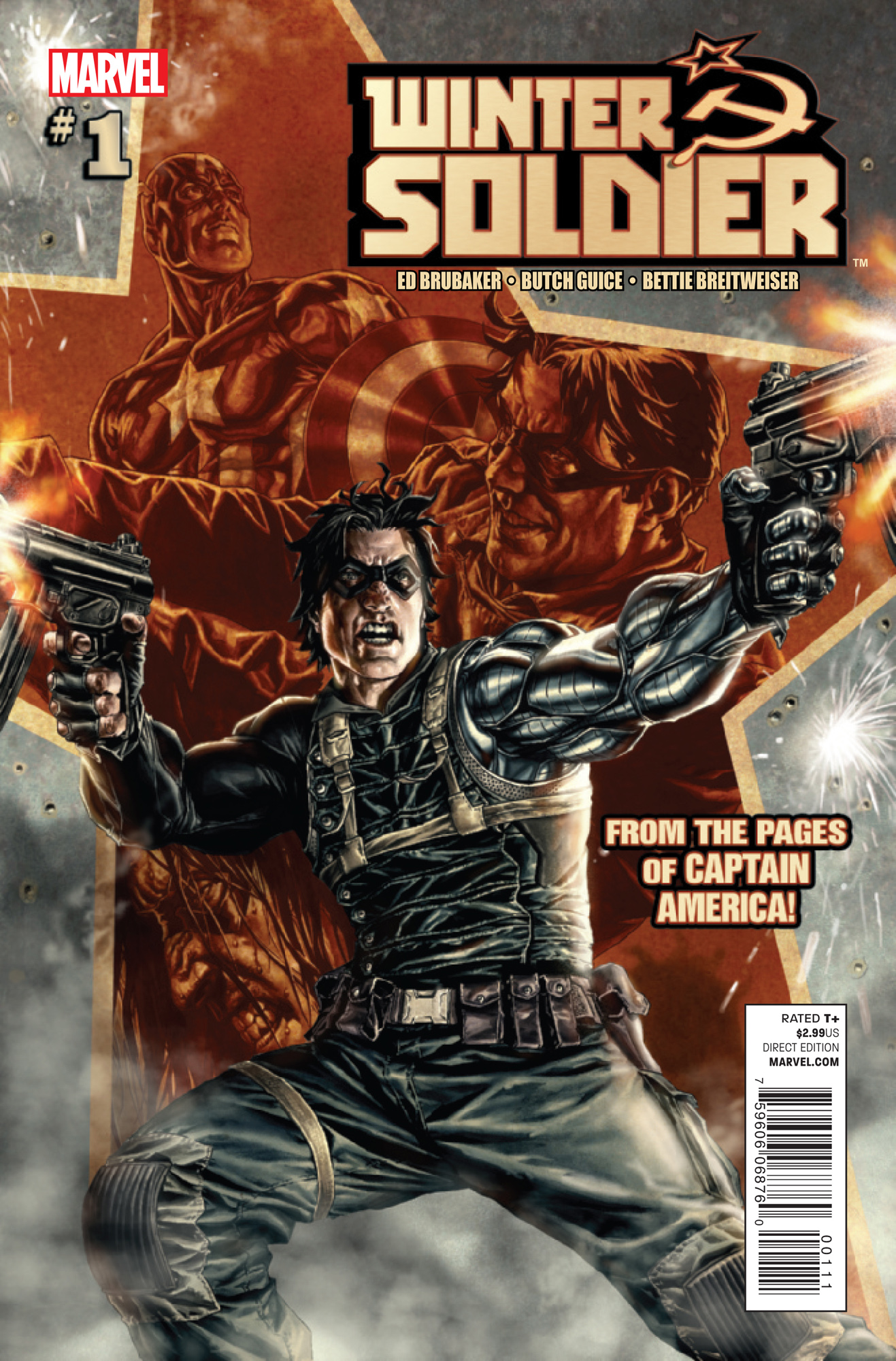 In Winter Soldier #1, the connection to the former Soviet Union is clear. The familiar 'hammer and sickle" emblem, an illustration of the egalitarian roles of both industry and agriculture of the Soviet Union, depicted in the title is an unmistakable icon of a by-gone era. Or, as the pages of Winter Soldier reveal, perhaps not as by-gone as we might want to believe. Even the smaller star above "Winter Soldier" appears to suggest Communism, or the threat of Communism is not so far removed from our current political theatre.
In Winter Soldier #1, the connection to the former Soviet Union is clear. The familiar 'hammer and sickle" emblem, an illustration of the egalitarian roles of both industry and agriculture of the Soviet Union, depicted in the title is an unmistakable icon of a by-gone era. Or, as the pages of Winter Soldier reveal, perhaps not as by-gone as we might want to believe. Even the smaller star above "Winter Soldier" appears to suggest Communism, or the threat of Communism is not so far removed from our current political theatre.
In the Winter Soldier, we find Barnes and his partner, Natalia Romanova a/k/a Black Widow, discovering a trio of Soviet-era assassins have been activated throughout the United States. James Barnes, throughout issue #1, refers to his physical training, mental conditioning, and re-education within the Soviet spy apparatus, along with the three other assassins. These assassins appear to have been activated by a resurgent Spetnatz (Russian Special Operations/Special Forces) for some undetermined purpose. But, I'll get the plot in a moment. First, let me track down some comic book-based geography.
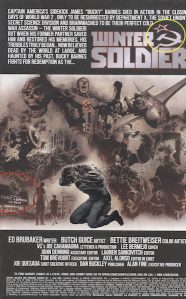 The opening scene in Winter Soldier shows James Barnes buckling from the psychological weight of his past. We see a montage of events, from his first days at Fort Lehigh U.S. Army base, fighting alongside Captain America, the Red Skull, to his eventual demise as "Bucky" and his rebirth as the Winter Soldier.
The opening scene in Winter Soldier shows James Barnes buckling from the psychological weight of his past. We see a montage of events, from his first days at Fort Lehigh U.S. Army base, fighting alongside Captain America, the Red Skull, to his eventual demise as "Bucky" and his rebirth as the Winter Soldier.
To the left is our imperfect hero, as drawn by Butch Guice. In these images, which I have used to highlight and illustrate the educational use of a great comic, I call-out some of the evident geography. I've discussed the iconography of the star/hammer and sickle above (noted by the yellow circle, left). Fort Lehigh does not exist in the Real World. Fort Lehigh, sometimes referred to as Camp Lehigh, is a fictional U.S. Army installation which had been abandoned prior to Steve Rogers and the Super Soldier experiment. Fort Lehigh, though fiction, was located in Virginia, obviously a real U.S. state.
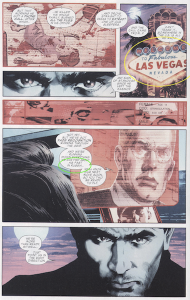 Many books move from geographic location to geographic location quickly. Paying attention to clues can help one keep abreast of the storyline. Devout readers of any genre will build "cognitive maps" (mental maps) as the authors or writers drive the action forward. In Winter Soldier #1, we learn the USSR planted some "sleepers" in the United States, to be awakened for some nefarious purpose, no doubt. Nico Stanovich, a Russian Spetsnaz member, is being watched by a U.S. intelligence agency. Stanovich, operating under the guise of Nick Stanton, is frequenting some casinos in Las Vegas, NV. Las Vegas is a well-known hive of villainy not only in comic books but in Real Life. Organized crime, legalized prostitution, gambling, and the "what happens in Vegas, stays in Vegas" advertising scheme provides substantive evidence Las Vegas is a node for any criminal network.
Many books move from geographic location to geographic location quickly. Paying attention to clues can help one keep abreast of the storyline. Devout readers of any genre will build "cognitive maps" (mental maps) as the authors or writers drive the action forward. In Winter Soldier #1, we learn the USSR planted some "sleepers" in the United States, to be awakened for some nefarious purpose, no doubt. Nico Stanovich, a Russian Spetsnaz member, is being watched by a U.S. intelligence agency. Stanovich, operating under the guise of Nick Stanton, is frequenting some casinos in Las Vegas, NV. Las Vegas is a well-known hive of villainy not only in comic books but in Real Life. Organized crime, legalized prostitution, gambling, and the "what happens in Vegas, stays in Vegas" advertising scheme provides substantive evidence Las Vegas is a node for any criminal network.
Spetsnatz is an interesting organization. The Russian Spetsnatz consists of a number of Special Operation Units. Some Spetsnatz units have naval specialties, marine units for performing sea operations. Some Spetsnatz specialize for urban environments. In many ways, the Russian Spetsnatz are the mirror image of the U.S. Special Forces units. Both U.S and Soviet/Russian special force units were born out of World War Two.
 During World War Two, the development of intelligence services created very elaborate global spy networks. Every major country ran operations. The United States created the Office of Strategic Services (OSS) during World War Two. The OSS ran spys throughout Europe and Russia to gather news of troop movements, adequacy of food supplies, labor force, raw materials, public sentiment, etc. While spies gathered intelligence, the tactical removal of people or missions against "hard targets" was somewhat problematic. The U.S. military often had to create ad-hoc special teams to conduct rescue missions, sabotage, or simply perform surveillance. Eventually, the U.S. Army, Navy, Air Force, and Marines would formally develop teams. The Green Berets and Rangers, Delta Force, and SEAL would arise in the late 1940s and in the 1950s to address critical tactical and strategic needs. Spetsnatz is the Soviet/Russian equivalent being created during the same timeline for performing similar operations for Mother Russia.
During World War Two, the development of intelligence services created very elaborate global spy networks. Every major country ran operations. The United States created the Office of Strategic Services (OSS) during World War Two. The OSS ran spys throughout Europe and Russia to gather news of troop movements, adequacy of food supplies, labor force, raw materials, public sentiment, etc. While spies gathered intelligence, the tactical removal of people or missions against "hard targets" was somewhat problematic. The U.S. military often had to create ad-hoc special teams to conduct rescue missions, sabotage, or simply perform surveillance. Eventually, the U.S. Army, Navy, Air Force, and Marines would formally develop teams. The Green Berets and Rangers, Delta Force, and SEAL would arise in the late 1940s and in the 1950s to address critical tactical and strategic needs. Spetsnatz is the Soviet/Russian equivalent being created during the same timeline for performing similar operations for Mother Russia.
Later in the first issue, James and Natalia catch a break. They find themselves racing through the rain to the fairly mundane environment of Minnesota. Not sure where their destination ends up being, though to fly from Las Vegas to Minneapolis is about 1,300 nautical miles. James and Natalia might have better airline departure times than mere "normals" and could probably cut the regular 3 hr flight time down to perhaps 2 hrs, given some form of S.H.I.E.L.D assistance. Would James and Natalia fly Southwest? I'd think not. Then, there are the issues of baggage claim, rental car, getting directions out of the city. James would not make it past security with his arm, let alone all of his weapons. Thus, having a secret organization to work through for planning travel is probably a huge benefit to heroes lacking mutant flying genes, superhuman powers, the endowment of alien technology, or being able to command the cosmic powers of the Universe.
Latveria is a popular location in many Marvel titles. Latveria is the home country of Victor Von Doom, the nemesis of the Fantastic Four, and Iron Man, to some extent. Nestled in the Banat region of northern Serbia, surrounded by the Carpathian Mountains, Victor Von Doom is somehow able to leverage what, under normal conditions, would be a minuscule global influence and project power and influence on numerous occasions, often bringing the FF, et. al., to their knees. While Latveria does not exist, the other geography does exist. The small fictional region wedged between Romania, Hungary, and Serbia was once home to the Thracians, but also fell under the dominion of the Goths and later the Huns. Victor Von Doom hails from the city of Doomstadt, appropriately enough (the fictional capital of Latveria); "Von" means "from" or "of" in German, and can indicate noble lineage, in case you didn't know.
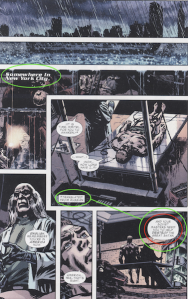 Later in the same book, we are introduced to a Russian scientist, the apparent mastermind of the sleeper program Barnes and Romanova are trying to shutdown. Professor Ivan Kragoff a/k/a Red Ghost was the original mastermind behind a number of Soviet science programs, one of which led to the training of the Winter Soldier. In one scene, we see the professor awakening a sleeper, providing the barest of briefs.
Later in the same book, we are introduced to a Russian scientist, the apparent mastermind of the sleeper program Barnes and Romanova are trying to shutdown. Professor Ivan Kragoff a/k/a Red Ghost was the original mastermind behind a number of Soviet science programs, one of which led to the training of the Winter Soldier. In one scene, we see the professor awakening a sleeper, providing the barest of briefs.
"Dmitri, it is time for you to awaken." Dmitri's response has to be translated from Russian, as he believes himself to be in Russia. Professor Kragoff reminds Dmitri to "speak English; you're in America, now." Obviously, action has moved forward in time, and across geography, as Dmitri was most likely placed in his sleeper mode while in Russia and transported to the United States.
However, as I read the book I noticed a fairly severe historical error. In the last panel, Professor Kragoff is entreating Dmitri to prepare for his assignment. "And your Soviet masters need you to help destroy the Great Satan." No Russian scientist real, or fictional, would never call the United States the "Great Satan." Calling the United States the "Great Satan" connotes the conflict between the United States and the Soviet Union as one of religion, or with religious undertones. The Soviet Union not only discouraged religion, all citizens were officially atheists. Members of the Communist Party certainly would profess no religious leanings.
Furthermore, the term "Great Satan" was a term not used by the Soviet Union, but by Iran. In the late 1970s, prior to the overthrown of the Iranian government by religious radicals, referred to the United States as "the Great Satan." For Iranian leaders to refer to the United States as the "Great Satan" makes perfect sense; after all Iran is officially known as "The Islamic Republic of Iran."
The error is not egregious enough in my opinion to detract from the story. I would only encourage the writers to check their sources more thoroughly before their characters make such comments. Other readers may not be as forgiving. On the other hand, close scrutiny of the book, the story, coupled with my own knowledge of world history and geopolitical events allowed me to pick up on this subtle flaw and use the error as a teaching moment.
However, I can understand why Brubaker and Sankovitch, et. al. wanted to take the story in this direction. The Soviet era of science research was fascinating, especially under Stalin. Stalin had some interesting ideas, one of which was the creation of a "super-soldier." Both Staling and Hitler had predilections toward the building "master races" and people who could work fervently, soldiers who could fight endlessly, with strength, skill, agility, with ferocity not available in a "normal" human.
 While no straight line relationship can be drawn between Stalin and some of the Soviet military research, anecdotal evidence seems to suggest Stalin gave a tacit acceptance for many different types of secret research. The cover of Winter Soldier #5 shows Barnes barely holding his own against nothing other than a gorilla wielding a Gatling gun, or what might be referred to today as a "mini gun." While far-fetched even for the 21st century, if one were to dive into the Soviet archives one might be surprised to learn Soviet scientists were trying to figure out how to hybridize differing animal species, including the creation of a chimp-human hybrid [link]. History will show these efforts began long before Nazism or Stalin, yet history does provide marvelous fodder for material, technologies, and intrigue even into the 21st century.
While no straight line relationship can be drawn between Stalin and some of the Soviet military research, anecdotal evidence seems to suggest Stalin gave a tacit acceptance for many different types of secret research. The cover of Winter Soldier #5 shows Barnes barely holding his own against nothing other than a gorilla wielding a Gatling gun, or what might be referred to today as a "mini gun." While far-fetched even for the 21st century, if one were to dive into the Soviet archives one might be surprised to learn Soviet scientists were trying to figure out how to hybridize differing animal species, including the creation of a chimp-human hybrid [link]. History will show these efforts began long before Nazism or Stalin, yet history does provide marvelous fodder for material, technologies, and intrigue even into the 21st century.
I selected Winter Soldier for an analysis as the character of James Barnes can be traced back in real-time to World War Two. Both James Barnes, as Bucky, as Captain America, and then as the Winter Solder captures a timeline of geopolitical intrigue which exists not only in comic books but manifests in the real world. The Winter Soldier has little other than physical training and wits to address dangers and crises; a bionic arm provides some advantage over adversaries, but he is otherwise mortal. His partner, Black Widow, is similarly adept physically but possesses no supernatural powers, no particular genetic augmentation, or physical augmentation. These characters are vulnerable and could easily make the transition of the small screen.
The Winter Soldier and Black Widow also engage in real-world geopolitical machinations. They are spies, sent around the world to carry-out covert operations where the United States government needs "plausible deniability." These characters then provide ample material for a geographer like me to discuss their exploits in a context of geography, of explaining geography, incorporating history, and perhaps some science along the way. Few other Marvel books provide the ability to examine, analyze, and interpret the geography found within the books. The new "Hawkeye" run is a good example, perhaps Daredevil and Iron Man. Many of the Marvel titles splinter off into other dimensions making geographical analysis irrelevant. DC, on the other hand, has several titles, like Arrow, most of the Batman titles, Nightwing (who is moving to Chicago), Swamp Thing, Animal Man, Constantine, the Before Watchmen series, which have settings in familiar locations and familiar geography.
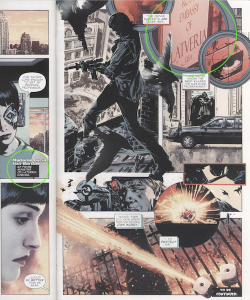
No comments:
Post a Comment